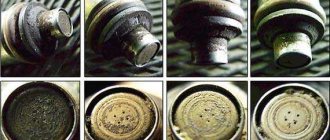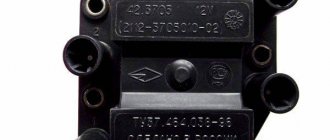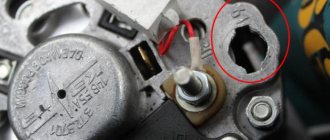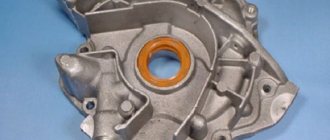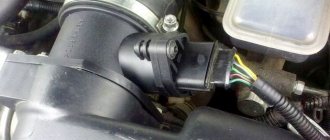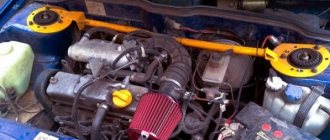The design of any car requires impulse conductors from the ignition system to the fuel combustion system (directly to the spark plugs). They are also found in the VAZ 2114. These are high-voltage (HV) wires. When the impulse does not pass or the discharge has insufficient power, the gasoline in the cylinders does not burn completely, and the engine operates intermittently.
High-voltage wires VAZ 2102
Therefore, it is very important to know what resistance should be on the high-voltage wires of the VAZ 2114, and what needs to be done if it does not meet the standard.
How to check high-voltage (HV) wires and determine their resistance
The main task of high-voltage wires is to transmit a current pulse from the ignition coil to the spark plug.
Timely and guaranteed ignition of the fuel in the cylinder depends on the quality of current transmission, which entails normal, correct operation of the engine.
For various reasons, high-voltage (HV) wires may not conduct at all or conduct only a small part of the current pulse from the ignition to the spark plug.
The main reasons for the malfunction of explosive wires are the following:
- core rupture;
- current leakage (breakdown through insulation);
- resistance is higher than normal;
- poor contact with the spark plug;
- rupture of the conductor.
With faulty explosive wires, the engine runs intermittently and produces extraneous vibrations, because In some cylinder the combustion of the mixture occurs with a delay.
When do you need to replace high voltage wires?
Most cars do not indicate routine replacement of explosive wires. But there are several main signs that indicate that there are problems in the operation of the ignition system and the wires are to blame:
- The car started to have difficulty starting, this happens especially often in rain, fog or simply damp weather.
- When the engine reaches medium or high speeds, it begins to work intermittently.
- If the center wire is damaged, the engine simply stalls.
- The engine power is significantly reduced, it becomes dull, and accelerates poorly.
- Gasoline consumption increases, sometimes by 30-50%.
- After starting the engine, the Check Engine light remains on.
All of these signs indicate that high voltage wires may have broken through and should be replaced. This happens because the insulation dries out over time and becomes outdated, cracking due to high humidity and temperature changes. In this case, it is better to check the explosive wires with a multimeter to assess their resistance.
Another reason for the problem is oxidation of contacts. This occurs at the junction of the spark plugs and the high voltage unit. If it is not possible to check the high-voltage wires with a tester, you can attach the tip at a short distance from the metal parts of the engine and turn on the ignition. The quality of the spark can be used to assess the condition of the wire. An important parameter is the resistance of armored wires, which can only be assessed using special equipment.
Seal
Checking high voltage wires
The first sign of a wire malfunction is the presence of an external spark on the explosive wires. Easy to see in the dark by looking under the hood.
The next method is also best done in the dark: take a piece of wire and strip it on both sides. Next, we connect the wire with one end to ground (battery or car body), and with the other end we run it along the wires at the joints, caps, etc. if there is a leak, a spark will form.
To check the resistance of the wires, we need a multimeter in ohmmeter mode.
In order not to confuse the wires, it is more convenient to check them one by one, i.e. remove the wire from the 1st cylinder and remove the other end of this wire from the ignition module.
- Turn off the ignition.
- Remove one end of the wire from the cylinder.
- Remove the other end of the wire from the ignition module (as in the figure).
- We connect both ends to an ohmmeter and watch the readings.
- We carry out the same operation on all wires.
For serviceable wires, the resistance should vary from 3.5 to 10 kOhm, depending on the manufacturer (written on the wire insulation). And the permissible spread is 2-4 kOhm. If the spread is greater, then the wires need to be replaced ( Replacing VAZ high-voltage wires ).
Carburetor Feature
On a carburetor engine, you can unscrew the spark plug and place it on the cylinder head together with the armored wire. Next, crank the crankshaft a little with the starter and watch for a spark. The engine is a mass, so a strong spark must be produced. If there is little or no spark, then the problem is in the wire.
But, the method will work if all the candles are in excellent condition. After checking, you can additionally inspect the wire visually or “pierce” it with a multimeter.
We also recommend that owners of carburetor internal combustion engines initially check the central high-voltage wire going to the distributor. This will help identify the problem if the engine does not start or the power has dropped very much. Perhaps the central one does not supply enough voltage to the others through the distributor.
A similar procedure cannot be carried out with an injection engine, because the electronic switch and engine control unit will fail.
Resistance of high voltage wires
We compare the results of the readings. The permissible spread on the wires is 2-4 kOhm. If more, then the explosive wires need to be replaced. By the way, you need to replace the wires as a set, not one at a time. Each manufacturer has a different high-voltage wire resistance.
Let's look at the most common wires:
- Tesla. Resistance 6 kOhm (fake Tesla 8 kOhm).
- Slon. Resistance from 4 to 7 kOhm (4 on the first and almost 7 on the last).
- ProSport. Resistance is almost 0.
- Cargen. Resistance 0.9 kOhm (each wire has a different resistance due to different lengths, rounded values are shown).
Source
Field repair
If urgent repairs are needed, then after identifying the problem wire, find the damaged area and clean it with a knife. Next, you will need a copper-based connector, which is secured with regular twisting.
Afterwards everything needs to be isolated, which is the main problem. Regular electrical tape requires 8-10 layers for safety, plus moisture forms between the layers during winding.
The method will not return all the power, but it will easily allow you to get to the nearest service station or postpone repair of the ignition system for a couple of days.
Checking high-voltage wires with a multimeter on a VAZ 2114
HF wires (stand for high-voltage) are needed as direct impulse conductors from the ignition device to the fuel ignition system (directly to the spark plugs). If the pulse does not flow or does not flow properly, the gasoline will not burn properly in the cylinder and the engine will not operate as it should.
High-voltage wires VAZ 2114
Naturally, high-voltage wiring tends to fail. Signs of malfunction of high-voltage wires may be the following:
- The wiring is broken
- The wiring is broken, current is flowing past
- On the contrary, the wiring has heated up, the resistance is higher than normal
- The fine conductive vein has ruptured
At the same time, with all this, the engine will definitely shake and twitch. By the way, if you look under the hood and see how the wires sparkle when the ignition is on, then this is a direct guide to replacing the wires!
How the wires are arranged
The wiring structure is the same as that of the electrical wiring in the apartment. A large number of copper wires are combined into a core. On top of the core there is a core and an insulator. The outer insulating layer usually consists of a silicone, polyethylene, polyvinyl chloride, rubber shell. The additional shell protects against the destructive effects of fuels and lubricants.
High-voltage wires VAZ 2114
What are the signs of faulty high-voltage wires:
- Broken wiring.
- Leakage current.
- Warming up wiring.
- Rupture of current-carrying conductors and insulation.
Broken wiring
If the wiring is faulty, the engine will stall and stall. If you find sparking wiring under the hood, it must be replaced immediately.
Wiring characteristics
In this case, a basic skill is required on how to check high-voltage wires with a multimeter. By the way, you can probably check in another way, but this is the most correct and logical. But for now let’s talk about something else, even if you realized that the explosive wires of the VAZ 2114 are dead, in any case, you will have to buy new ones.
As it turned out, high-voltage workers have their own GOST number - 14867-79. These numbers indicate the quality of the wires - that they are high-voltage. Also, on domestic wiring there is a brand - PPOV: polyethylene wire, irradiated, with a polyvinyl chloride sheath.
Wiring check
Checking high-voltage ignition wires begins with a simple diagnosis, because all of the above symptoms of problems may indicate a breakdown of other parts of the engine system or something else. For a simple check it is better to wait until dark. Then you need to expose a small section of the wire on one side and the other and close one end to the body of the car or battery, and the second is needed for maneuver: we move it along the wiring joints, plugs, and so on. When there is a hole there will be a spark immediately. The result is obvious - replacement is required. But this method is primary; it concerns direct current leakage, which is not always the reason for the non-operating state of high-voltage devices. In the case of voltage, such a number will not work.
To measure it, you need to know what resistance the high-voltage wires should have. After all, each wire from a specific manufacturer has its own resistance, technical characteristics and dimensions:
1) Tesla - 6 kOhm, it is often counterfeited, then you can squeeze out as much as 8 kOhm
3) ProSport tends to zero
Checking high-voltage ignition wires with a multimeter
For measuring work, you need a simple multimeter, which we switch to ohmmeter mode. We measure one wire at a time, removing one by one from the cylinders from left to right and from the coil itself. The procedure is simple:
- make sure the car is turned off
- remove the end of the wire from the fastener on the cylinder
- remove the opposite end from the ignition coil mounting
- you need to connect both ends to the multimeter
- read the readings
- write them down so as not to forget
- We do this three more times with the remaining wires
Normal resistance is numbers in the range from 3.4 to 9.8 kOhm. Of course, all this depends on the manufacturer; this parameter is printed on the rubber skin of the wire. If you have a difference with the permissible value, which varies from 2 to 4 kOhm, this is normal. But no more! If more, then the wires are not suitable for driving, they need to be changed.
We always replace wires as a set! Even if one has fallen into disrepair, and the rest are in good technical condition.
That's basically it. Now you should replace the old wires with the purchased new ones.
Source
Signs
You shouldn’t go to the ignition system wires for every internal combustion engine problem, because they are only responsible for it. More specifically, their zone of influence is associated with arson of the fuel mixture, so the symptoms are:
- problematic engine starting (especially in the rain);
- “glitches” of electrical appliances, for example, radio tape recorders;
- floating idle speed;
- jerky acceleration;
- reduction in engine power;
- increased fuel consumption.
But, most of the symptoms can be caused by wear of the spark plugs, so we will check the armored wires with visual inspections and various instruments (multimeter and oscilloscope).
Visual inspection
You may find external damage, but the best way is to start the engine at night. Then the breakdown will give itself away with a spark, especially if the engine compartment is very wet, but you should not water the engine.
Additional wire
You can also find the breakdown location with an additional copper wire. Take the wire, strip its edges, and twist some of them into a half ring. Then connect one part to the body, and move it in a semi-ring along each armored wire. You will also see sparking at the breakdown site. In this case, you can wet the wires a little, but only a little.
Screwdriver
This method will reveal the very fact of penetration, but not its exact location. The task is to wind several turns on a long screwdriver and touch the cylinder head block with its end. Sparking will confirm the fact of the malfunction.
Disconnecting wires
Start the engine and disconnect the spark plug wires one at a time while observing engine operation. If the motor operation does not change when disconnected, then this wire is faulty and must be replaced.
This method is not suitable for everyone, since the wires are not publicly available everywhere. Basically, this access is provided to carburetor internal combustion engines, but some injection engines, for example, AvtoVAZ, also have this feature.
The absence of a spark does not necessarily mean that it is in good condition; it is not necessarily a matter of complete breakdown. Also, remember to wear insulating gloves to prevent electric shock.
How to check and replace high-voltage ignition wires on a VAZ 2114
High-voltage ignition wires of the VAZ 2114 are part of the ignition system, through which an electrical impulse is transmitted from the module to the spark plugs. When the current hits the spark plugs, the fuel mixture ignites in the combustion cylinders, which gives rise to a new stroke of the engine.
The design of the GDP, unlike conventional wires, is quite complex. In addition to the conductive core (which is made of copper) and protective insulation, they have metal tips and plastic protective caps.
GENERAL INFORMATION AND FEATURES OF GDP DESIGN
Unlike the rest of the car's wiring, high-voltage ignition wires have a rather complex design. They consist of plastic caps, metal contacts, an insulating layer and a copper conductor.
GDP insulation can be either single-layer or multi-layer, depending on the quality and cost of the wire. As a rule, all products from leading manufacturers have multi-layer insulation. The protective layer of GDP performs two main functions:
- Acts as a barrier that prevents current leakage;
- Performs the function of protecting the conductor from mechanical damage and aggressive environmental influences: fumes, fuels and lubricants, moisture, low and high temperatures.
The conductive core of the GDP is made of copper, since this material has minimal resistance and durability (about 8 years of operation). The conductive element of the GDP, according to GOST 14867-79, must meet the following requirements:
- Limit permissible voltage – 22 kV;
- Minimum breakdown voltage – 40 kV;
- Maximum electrical capacity – 100 pF/m;
At both ends of the wire there are metal tips that act as contacts, through which the VVP are connected to the coil and spark plugs.
Various types of explosive wire lugs
When purchasing, it is worth checking the high-voltage wires for the quality of the connection between the contacts and the core; it is necessary that they are firmly attached to the core and tightly connected to the spark plugs, since the lack of normal contact is one of the most common problems with VVP.
Plastic caps perform a protective function. They prevent moisture and dust from entering the contacts, and protect them from changes in ambient temperature.
High-voltage ignition wires VAZ 2114 - device
It is important to know: The efficiency of ignition of the mixture directly depends on the quality of the high-voltage wires, which means stable engine operation in different modes.
The classic model of the ignition system for all cars around the world provides for a set of five high-voltage carriers. The central cable supplies high voltage from the ignition coil to the distribution device - distributor. Next, four cables supply voltage to the spark plugs.
Modern cars use an electronic ignition system. The circuit does not change, but additional cables may be added if the flammable liquid is ignited by two spark plugs in each combustion chamber.
- conductive copper, graphite or non-conductive twisted conductors;
- ferroplast shell - insulator;
- metal wire screen;
- sealing hard shell;
- tips on both sides.
What else can I recommend?
In addition to the listed components, there are also such as Bautler, xopc.
Products from Bautler, which have proven themselves to be highly reliable and efficient among consumers
Bautler uses rubber for the insulating layer, which causes a slight thickening of the product, but allows the ignition parts to work in more difficult conditions.
We also can’t help but say something about xopc’s products. It has been present in the automotive market since 1995. Experts note that today xopc is one of the largest manufacturers of silicone cables in the Russian Federation. To manufacture its products, xopc uses imported raw materials. The production process is carefully controlled at all stages of production.
I would also like to say a few words about armored wires for car ignition systems. The first samples of such parts began to be used on vehicles intended for the Armed Forces. They were subjected to additional shielding with metal braiding to protect radio-electronic devices from interference. Currently, such armored wires can only be found on older cars. The achievements of the developers make it possible to produce armored wires without visible metal shielding.
In conclusion, I would like to recommend that car enthusiasts, if they need to replace armored wires or high-voltage wires, first of all follow the vehicle’s operating instructions. You can choose an elephant or another brand, but this should not be to the detriment of the power unit.
Signs of faulty armored wires of the VAZ 2114
The main signs of a malfunction of the VAZ 2114 armored wires are:
- Difficulty starting the engine;
- Unstable operation of the engine in idle mode;
- Increased hydrocarbon content in emissions;
- Radio interference, which can lead to malfunction of the multimedia system, electronic control unit and other devices
Therefore, in order to avoid lowering your ranking in search engines, a link to the source is required.
As a rule, when there is severe wear on the wire insulation, many microcracks appear, due to which current leakage occurs. As a result, the wire is not able to transmit to the spark plug a current that is sufficient in magnitude for its normal operation. This significantly increases the spark generation time and interferes with the correct operation of the engine cylinders.
Location of the ignition module of the old VAZ 2114
Quite often there are cases when wires are damaged as a result of contact with any engine elements. Situations of loss of cap tightness are also possible, and as a result - oxidation of contacts and current leakage. Regular cleaning of contacts is a mandatory procedure, especially when operating a vehicle in difficult climatic conditions.
What to pay attention to
First, check the wires for visible damage - melting and insulation damage. Rapid failure of wires can occur in the following situations: Vibration. The cause of wire failure may be engine vibration, which leads to loosening of the electrical contacts of the spark plugs. At the same time, the voltage supplied to the spark plugs increases. An increase in voltage can damage not only high-voltage wires, but also ignition coils.
High temperatures. Heat from the engine can melt insulation and wire lugs. A damaged tip disrupts the fixation of the wire and affects the operation of the corresponding spark plug. Damage to the insulation can lead to grounding of the wire to metal parts of the body, and there will be no sparking in the cylinder.
Abrasive impact. When high-voltage wires begin to touch engine parts (especially those with sharp edges), damage and breakage of the wires occurs. If this happens, there is a risk of the wire being grounded to the body.
Equipment Required: Digital Multimeter
Set the digital multimeter to measure resistance (Ohms, ?). Hold the tester's pins on both ends of the wire and determine its resistance. The Society of Automotive Engineers (SAE) has set the upper limit of the resistance value at 3,600 ohm-m. However, car manufacturers may recommend different values, so it is best to consult your vehicle's repair manual for reference.
Required equipment: 12-volt phase indicator
Connect the indicator to ground. Start the engine and run the indicator along all the wires. The appearance of a spark indicates damage to the wire insulation and the need to replace it.
Note
When checking for shorted wires, try to avoid contact with metal parts in the engine compartment.
Checking high-voltage ignition wires with a multimeter on a VAZ 2114 - step-by-step instructions
Checking high-voltage ignition wires begins with a simple diagnosis, because all of the above symptoms of problems may indicate a breakdown of other parts of the engine system or something else. For a simple check it is better to wait until dark. Then you need to expose a small section of the wire on one side and the other and close one end to the body of the car or battery, and the second is needed for maneuver: we move it along the wiring joints, plugs, and so on. When there is a hole there will be a spark immediately. The result is obvious - replacement is required. But this method is primary; it concerns direct current leakage, which is not always the reason for the non-operating state of high-voltage devices. In the case of voltage, such a number will not work.
Checking the resistance of armored wires of a VAZ 2114 with a multimeter
To measure it, you need to know what resistance the high-voltage wires should have. After all, each wire from a specific manufacturer has its own resistance, technical characteristics and dimensions:
1) Tesla - 6 kOhm, it is often counterfeited, then you can squeeze out as much as 8 kOhm
3) ProSport tends to zero
For measuring work, you need a simple multimeter, which we switch to ohmmeter mode. We measure one wire at a time, removing one by one from the cylinders from left to right and from the coil itself.
To check the high-voltage ignition wires on a VAZ 2114, you must do the following:
- Make sure the car is turned off
- Remove the end of the wire from the fastener on the cylinder
- Remove the opposite end from the ignition coil mounting
- You need to connect both ends to the multimeter
- Reading the readings
- Write them down so you don't forget
- We do this three more times with the remaining wires.
Types of damage and causes of their occurrence
One of the most common flaws occurs when a conductor is broken, i.e., it has ruptured. It is usually located where the metal tips of the explosives contact the coil, or at the junction with the spark plugs. As a result, an unnecessary spark is formed in the problem area - an electrical discharge that creates a parasitic electromagnetic pulse and reduces the voltage. It is he who is responsible for malfunctions in the car’s electronics: sensors and ECUs. The main causes of wire damage:
- careless handling of explosives in severe frost (cables become rigid and can easily break);
- too frequent removal and installation of high-voltage wires, especially if they are of low quality.
Another common malfunction is a break (complete or partial) in the electrical circuit. As a result, insufficient voltage is supplied to the electrode, or there is no voltage at all. This can be determined by the carbon deposits of the candle, which will be black and wet. Other causes and malfunctions:
- Electricity leakage is usually associated with a dirty ignition coil, distributor cap (module), as well as broken caps, which in this case lose their dielectric properties.
- The lack of sufficient voltage may be due to thermal damage to the spark plug caps located closer than the other ignition elements to the hot engine. However, this reason for the malfunction of explosives is usually caused by their low quality.
- Deterioration of electrical contact can occur due to constant vibration of the engine, as a result of which the connecting points become loose.
- A long service life affects the condition of the insulating layer, which gradually cracks due to high temperature, oil vapors, gasoline, antifreeze and ceases to fulfill its main function - to prevent current leakage. The insulation can also be damaged due to exceeding the maximum permissible voltage level produced by the ignition coil (if its primary winding is broken). When the cracks reach the conductive core, a breakdown to ground occurs, as a result of which the high-voltage pulse does not reach the spark plug.
Features of choosing VVPZ for VAZ 2114
When choosing a GDP for a VAZ, it is necessary to take into account two key factors - their resistance and breakdown voltage. The lower the resistance, the better the electrical impulse will be transmitted, and the magnitude of the maximum breakdown voltage determines how resistant the high-voltage wires on the VAZ 2114 will be to breakdowns.
The resistance value of products from different manufacturers differs from each other. As an example, we give you the resistance of the most popular types of GDP:
| Manufacturer | Resistance on cylinder No. 1 (kOhm) | Resistance on cylinder No. 2 | Resistance on cylinder No. 3 | Resistance on cylinder No. 4 | Breakdown voltage (kV) |
| Tesla | 3.27 | 4.16 | 5.02 | 6.26 | 50 |
| Cezar | 3.1 | 3.53 | 4.23 | 5.34 | 50 |
| Finwhale | 1.95 | 2.18 | 2.6 | 3.42 | 50 |
| Ween | 6.17 | 6.57 | 7.52 | 9.89 | 35 |
| Slon | 4.24 | 4.74 | 5.19 | 7.6 | 50 |
Expert opinion: The products of the Czech company Tesla receive the largest number of positive reviews from the owners of the fourteenth. Their wires have optimal resistance and high breakdown voltage, and at the same time they are truly made to last - they do not tan or crack.
The cost of the Tesla GDP set is about 500 rubles, Cezar – 450 rubles, Ween – 270 rubles, Finwhale – 600 rubles, Slon – 500 rubles.
Replacement and connection of high-voltage ignition wires of a VAZ 2114
Important to know: Incorrect installation and location of high-voltage wires can lead to sparks jumping from wire to wire or to ground, which, in turn, can lead to misfires and a decrease in the crankshaft speed when the car is moving at high speed.
The order of connecting high-voltage wires must be strictly sequential, since each cylinder of the engine corresponds to a specific socket on the ignition module. Considering that there is a numbering of the sockets on the ignition module body, the risk of confusing anything is minimal.
Connecting armored wires to the ignition module of a VAZ 2114
The procedure for connecting high-voltage wires of the VAZ 2114 injection type depends on the year of manufacture of your car. Fourteen cars before 2004 had 4-pin ignition modules installed, and cars after 2004 had 3-pin coils.
Service life of high-voltage ignition wires on VAZ family cars
According to the recommendations of Auto VAZ, replacement of high-voltage wires of the VAZ 2114 should be done every 30 thousand kilometers. In practice, motorists rarely comply with these replacement deadlines, since if the wires do not have any mechanical damage, they can travel about 100-150 thousand km.
Numbering of connection of armored wires to the ignition module of VAZ 2114
When the service life is exceeded, the internal resistance of the GDP increases, which negatively affects the transmission of the electrical impulse. This leads to problems with ignition and acceleration dynamics, since when the supply of current to the spark plugs is delayed, the normal engine operating cycle is disrupted.
Source


